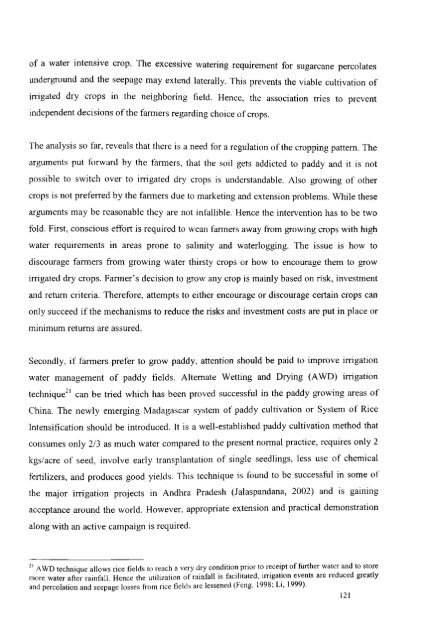Water Users Association and Irrigation Management - Institute for ...
Water Users Association and Irrigation Management - Institute for ...
Water Users Association and Irrigation Management - Institute for ...
Create successful ePaper yourself
Turn your PDF publications into a flip-book with our unique Google optimized e-Paper software.
of a water intensive crop. The excessive watering requirement <strong>for</strong> sugarcane percolates<br />
underground <strong>and</strong> the seepage may extend laterally. This prevents the viable cultivation of<br />
irrigated dry crops in the neighboring field. Hence, the association tries to prevent<br />
independent decisions of the farmers regarding choice of crops.<br />
The analysis so far, reveals that there is a need <strong>for</strong> a regulation of the cropping pattern. The<br />
arguments put <strong>for</strong>ward by the farmers, that the soil gets addicted to paddy <strong>and</strong> it is not<br />
possible to switch over to irrigated dry crops is underst<strong>and</strong>able. Also growing of other<br />
crops is not preferred by the farmers due to marketing <strong>and</strong> extension problems. While these<br />
arguments may be reasonable they are not infallible. Hence the intervention has to be two<br />
fold. First, conscious ef<strong>for</strong>t is required to wean farmers away from growing crops with high<br />
water requirements in areas prone to salinity <strong>and</strong> waterlogging. The issue is how to<br />
discourage farmers from growing water thirsty crops or how to encourage them to grow<br />
irrigated dry crops. Farmer's decision to grow any crop is mainly based on risk, investment<br />
<strong>and</strong> return criteria. There<strong>for</strong>e, attempts to either encourage or discourage certain crops can<br />
only succeed if the mechanisms to reduce the risks <strong>and</strong> investment costs are put in place or<br />
minimum returns are assured.<br />
Secondly, if farmers prefer to grow paddy, attention should be paid to improve irrigation<br />
water management of paddy fields. Alternate Wetting <strong>and</strong> Drying (A WD) irrigation<br />
technique 21 can be tried which has been proved successful in the paddy growing areas of<br />
China. The newly emerging Madagascar system of paddy cultivation or System of Rice<br />
Intensification should be introduced. It is a weII-established paddy cultivation method that<br />
consumes only 2/3 as much water compared to the present normal practice, requires only 2<br />
kgs/acre of seed, involve early transplantation of single seedlings, less use of chemical<br />
fertilizers, <strong>and</strong> produces good yields. This technique is found to be successful in some of<br />
the major irrigation projects in Andhra Pradesh (Jalasp<strong>and</strong>ana, 2002) <strong>and</strong> is gaining<br />
acceptance around the world. However, appropriate extension <strong>and</strong> practical demonstration<br />
along with an active campaign is required.<br />
" A WD technique allows rice fields to reach a very dry condition prior to receipt of further water <strong>and</strong> to store<br />
more water after rainfall. Hence the utilization of rainfall is facihtated. lrngatlOn events are reduced greatly<br />
<strong>and</strong> percolation <strong>and</strong> seepage losses from rice fields are lessened (Feng. 1998; Li, 1999).<br />
121
















